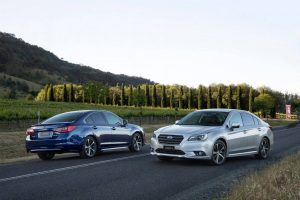Recalls: Subaru BN Liberty
Overview
Manufacturers, or importers, issue recalls for defects or faults which have the potential to cause injury. Generally, manufacturers will inform the original buyers if their vehicle is subject to a recall and of the steps required to remedy the defect or fault. Please note that the recalls below (if any) are for Australian-delivered vehicles only. Furthermore, the number of recalls should not be taken as an indication of a model’s reliability or its safety more generally.
Recalls: Subaru BN Liberty
2015 model year Subaru BN Liberty: pre-collision braking may not work
In June 2015, a recall was issued for ‘2015 model year’ Subaru BN Libertyvehicles that were equipped with pre-collision braking (PCB) and adaptive cruise control (ACC). If the brake lamp switch (BLS) failed, a software error may cause the PCB system not to operate as intended in an emergency situation or the ACC not to properly engage the brakes. As a result, the braking performance of the PCB and/or ACC systems would be compromised and could lead to an accident. To fix, a modified software program was to be installed on potentially affected vehicles (PRA 2015/14758).
2015 model year Subaru BN Liberty: electric parking brake may not release
In March 2016, a recall was issued for ‘2015 model year’ Subaru BN Liberty vehicles because the electronic parking brake (EPB) motor may ‘stick’ after the brake is engaged (as occurs when parking) and may not subsequently release. If the EPB did not release, the vehicle could not be driven until it was fixed, creating a potential hazard to the driver and other road users (PRA 2016/15274).
2017-18 Subaru BN Liberty: incorrect driving range indicator
In November 2018, recall campaign SI0492 was issued for 2018 model year Subaru BN Liberty vehicles that were produced prior to 1 August 2018. Due to a programming error in the Combination Meter Display (CDM) unit, the driving range indicator may provide inaccurate information about the distance that may be driven before the vehicle’s fuel tank was exhausted; the low fuel warning light would, however, still illuminate when the fuel level was critically low. Nonetheless, drivers who relied solely on the indicated driving range could inadvertently run out of fuel and, if this occurred while the vehicle was being driven, would pose a hazard to vehicle occupants and other road users. For the VINs of the recalled Subaru BN Liberty vehicles, please see PRA 2018/17143.
2018-19 Subaru Liberty 3.6: deformed fuel pump impeller and loss of power
In August 2021, recall campaign SRT-311 was issued for 2018-19 Subaru Liberty 3.6 vehicles. The fuel pump impeller may not meet manufacturing specifications and could therefore deform. If this occurred, the fuel pump may stop working and the engine may stall, causing a loss of power; this condition increased the risk of a collision and injury to vehicle occupants and other road users.
For the VINs of the recalled vehicles, please see REC-001697.
2015-18 Subaru BN Liberty: vehicle could roll away while in ‘park’
In August 2022, recall campaign SRT324 was issued for 2015-18 Subaru BN Liberty vehicles. Due to a manufacturing defect, the Electronic Park Brake (EPB) adaptor cord connector may not operate as intended. This condition could result in the vehicle moving or rolling away whilst the ‘park’ was selected, increasing the risk of a collision and injury to vehicle occupants and other road users. For the VINs of the recalled vehicles, please see REC-005485.
Problems and faults: Subaru BN Liberty
Overview
This section identifies potential problems, causes and fixes based on the experiences of owners and repairers, online sources and technical service bulletins. This information is provided solely for reference purposes and AustralianCar.Reviews recommends that only properly qualified persons carry out repairs or modifications. Furthermore, the number of items below should not be taken as an indicator of a model’s reliability or the frequency with which they may occur.
To report a problem or fault to the AustralianCar.Reviews team, please use the Contact Us form. Note that AustralianCar.Reviews does not offer advice on automotive problems or disputes; such enquiries will not receive a reply. For vehicles purchased from dealers after 1 January 2011, please see our Australian Consumer Law fact sheet.
2015-17 model year Subaru BN Liberty 2.5i CVT: bump sensation at idle
In May 2017, Subaru issued Technical Service Bulletin 16-104-17R for 2015-17 model year Subaru BN Liberty 2.5i vehicles that had continuously variable transmissions (Subaru’s ‘Lineartronic’ CVT). According to the bulletin, the driver may experience a ‘bump’ sensation once the CVT had reached operating temperature, the CVT was in ‘Drive’ and the engine was idling. While the service bulletin described it as a ‘bump’ sensation, owners have described it as a ‘jolt’ which is comparable to a rear-end collision. To address this problem, a software update was introduced for the transmission control module (TCM) for 2017 model year vehicles.
‘Lineartronic’ CVT slow to engage drive/reverse
Subaru’s ‘Lineartronic’ continuously variable transmissions (CVTs) are slower to shift to/from reverse or drive than conventional automatic transmissions – this occurs because significant pressure must be generated before the sheaves (i.e. the sides of the pulley that contact the metal belt) can clamp the belt such that it will not slip. According to Subaru service manuals, the normal delay or lag when switching into reverse or drive from park is 1.5 seconds or less.
Some Subaru owners, however, have reported delays of around three (3) or four (4) seconds when switching between reverse and drive. While re-flashing the transmission control module (TCM) and replacing the CVT fluid have reduced the delay to within Subaru’s normal range, the delay has subsequently increased over time.




